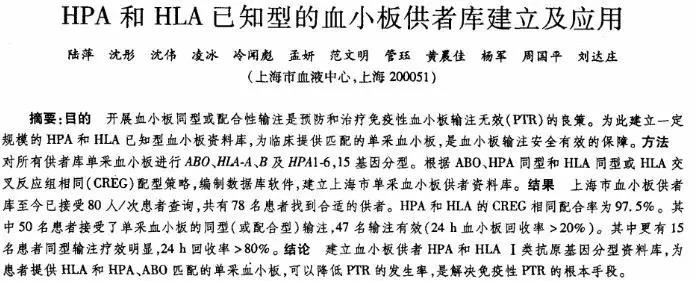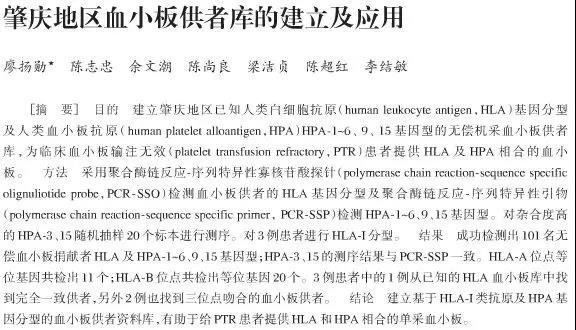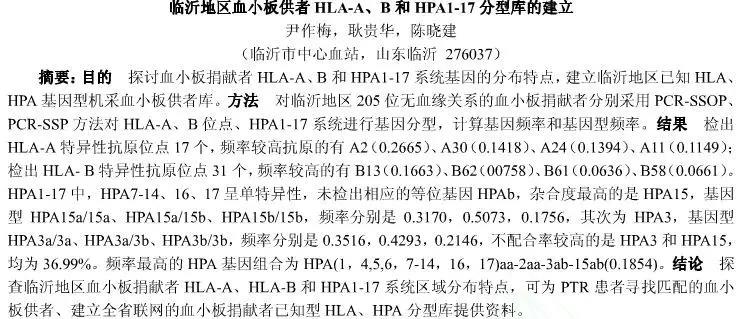

 Now Location:Home--News Center--Industry News
Now Location:Home--News Center--Industry News
In recent years, with the progress of blood transfusion, platelet transfusion has become an important part of transfusion medicine. Platelet transfusion is performed on patients with thrombocytopenia or platelet dysfunction to achieve the goal of hemostasis or prevention of bleeding. However, due to the influence of immune and non immune factors, after multiple platelet transfusions in clinical practice, the bleeding trend not only does not decrease, but even worsens the phenomenon of bleeding, which is commonly known as ineffective platelet transfusion (PTR). Among them, nearly 80% are caused by non immune factors, and 20% are caused by immune factors. And in the ineffective platelet transfusion caused by immune factors, about 80-90% is caused by the homologous immunity of HLA (human platelet antigen, HLA) class I molecules (mainly HLA-A, B), while about 10-20% is caused by the homologous immunity of HPA (human platelet antigen, HPA). Patients with PTR may experience extreme thrombocytopenia, significant bleeding, fever, rash, difficulty breathing, and in severe cases, even life-threatening, which has become a major challenge for clinical doctors.
So, are we just powerless to deal with PTR? Of course not. Today, let's delve into the immune factors that cause PTR. As mentioned above, the immune factors that make platelet transfusion ineffective are mainly HLA class I molecules (mainly HLA-A, B) and HPA induced alloimmunity. At present, in clinical practice, prevention is the main treatment for immune induced PTR. The treatment method is as follows: for patients who require multiple transfusions but have not yet developed PTR, transfusing platelets with HLA and/or HPA matching matches can effectively avoid the occurrence of PTR. For patients who have already developed PTR in clinical practice, HLA and/or HPA matching infusion can significantly improve treatment efficacy and achieve treatment goals. However, to achieve HLA and/or HPA matching infusion, it is necessary to establish a database of platelet donors with known HLA and/or HPA types.
Establishing a database of platelet donors with known HLA and/or HPA types, reducing blind matching, can effectively and quickly provide patients with matching platelets, and reduce the occurrence of PTR. Building a database has become the common aspiration of many blood transfusion experts both domestically and internationally.
Shanghai region

Guangzhou region


Sichuan region

Shandong region

In summary, the concept of building a database has deeply rooted in people's hearts and is also a trend. According to literature reports, for populations of the same ethnic group with the same genetic background, a database of platelet donors with a capacity of 500-1000 and clear HLA typing can theoretically meet the needs of one million people who need to receive cross reactivity matching platelets. In other words, if the blood transfusion centers in various regional cities can effectively classify HLA and HPA among the population in their respective regions, calculate gene frequencies, and statistically analyze and compare genotype frequencies with populations in different regions, then it is just around the corner to establish an exclusive HLA database for Chinese samples through regional integration. Due to differences in the distribution frequency of HPA among different races and regions, studying the genetic polymorphism of HPA provides reliable scientific basis for human genetics.
Establishing a platelet donor database based on HLA-I antigen and HPA gene typing not only meets clinical platelet typing needs, but also provides effective assistance for the treatment of patients with ineffective platelet transfusion, saving reagents while reducing examination time. This helps to provide PTR patients with HLA and HPA combined single platelet collection, while improving the utilization rate of hematopoietic stem cell databases and achieving maximum social benefits.
[Contact Information]
Address: 225300, East Side, 2nd Floor, Building G75, Phase 4, Yaocheng, Medical High tech Zone, Taizhou City, Jiangsu Province
Phone: 0523-86201335-8010 (product consultation)
Website: www.wehelpinc.com
Email: sales@wehelpinc.com
